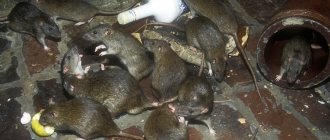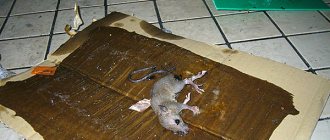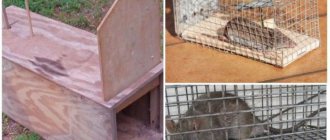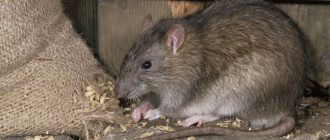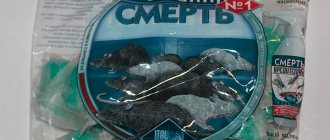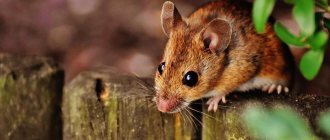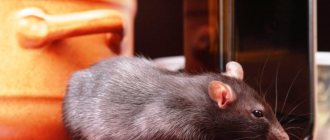Author: Michael Potter Updated: April 17, 2020
There are two types of rat baits: food (non-toxic) - for luring rats into a trap, and poisonous - for killing rodents. Food baits can be used for all types of rat traps, and poisons are most often used in conjunction with special stations for safety reasons. In this review we will talk about the 8 best poisons for rats and mice.
After ingesting poison, rodents die within a few hours to several weeks. Mice are smaller than rats and can die within a day, but rats die more slowly (a week or two). Poison baits are toxic and can kill any animal, including pets (cats and dogs), squirrels, raccoons and other wild animals. Be careful when using them around your pets and small children. Otherwise, instead of using poisons, you are better off purchasing an ultrasonic pest repeller to safely eliminate the animals that are bothering you.
How does rat poison work?
As a rule, everyone is interested in how this drug works on rodents in order to determine its effectiveness.
There are several groups of such toxic substances. For example:
- Instantly toxic substances . If they eat bait containing such a substance, the rodents die as soon as the poison enters their stomach. There are poisons for rats with a mummifying effect, which is due to the presence of special additives that dry out the victim. As a result of this effect, dead rodents do not decompose, so there is no unpleasant odor.
- Long-acting countermeasures . In this case, the rodent that has tasted the poisonous bait lives for another couple of weeks, or maybe less, depending on the concentration of the poison in the body. The toxic substance acts slowly, destroying the circulatory system of animals. As a result, they die from instant internal bleeding.
Each type of poison is characterized by the peculiarities of its effect on the rodent body: some toxic substances negatively affect the digestive system, some substances have a paralyzing effect, and some act on the nervous system.
Comparative table of poisons from rats and mice
| Product | Type of poison | Active Ingredient | Speed of action on rodents | Price |
| Tomcat All Weather Bait Chunx, 4 Lb | Small blocks | Diphasinone | Kills slowly, requires several meals | ~$24.46 |
| JT Eaton 709-PN Bait Block Rodenticide Bait | Small blocks | Diphasinone | Kills slowly, requires several meals | from ~$24.49 |
| D-Con Ready Mix Baitbits Mice Rats | Granules | Brodifacoum | A single dose is enough | ~$31.99 |
| Farnam Home & Garden Just One Bite Bar | Single block (with the ability to divide into smaller ones) | Bromadiolone | A single dose is enough | ~$9.02 |
| Havoc Rat & Mouse Bait | Granules | Brodifacoum | A single dose is enough | ~$73.59 |
| Protecta LP Rat Bait Station | Bait station | – | – | ~$14.30 |
| Rat death | Bait | Brodifactum, Rocentide | A single dose is enough | 53 RUR |
| Bait granules “Help” | Bait | Diphasinone | Kills slowly, requires several meals | 29 RUR |
| Bait granules “Ratron” | Bait | Brodifactum | A single dose is enough | 226 rub. |
| Tomcat Mouse and Rat Poison Bait | Liquid poison | Diphasinone sodium salt | Kills slowly, requires several meals | ~$19.62 |
The most frequently asked questions about Havoc Rat & Mice bait
Can I use Havoc inside my home? What's the best way to do this?
Yes, Havoc Rat & Mice Bait can be used indoors. You can either scatter the granules around or simply open the bag and place it where the rats are active.
There are mice in my attic. Can I put bait there? It's quite difficult for me to get into the attic, so I'm afraid that the smell of dead mice will bother my family later.
Unfortunately, the smell will be there in any case, because... not a single bait dehydrates the rodent from the inside (only in this case the smell could be less strong). In a situation like yours, the two most acceptable options are to make the attic entrance more accessible and place poison there, or to use an electronic rat repeller.
What is the shelf life of the product?
You don't have to worry about this: Havoc bait can be stored for up to 4 or 5 years, and such a long storage period will not affect its effectiveness since the bags are securely sealed.
Is it true that Havoc is equally effective on rats and mice?
Yes, in practice, bait attracts and kills both mice and rats equally well.
Attention! You should know that rats and mice are very cunning creatures, so if they see that someone has died from bait, they may refuse such a treat. Therefore, if you see that animals do not eat it, buy another product.
What does rodent poison look like?
Only those who constantly fight rodents know what poison looks like for rats. At the same time, most of the population does not even know what it is.
The rodent control product is sold in powder or granule form, as well as in the form of compressed briquettes and tablets. This substance may or may not have an odor, indicating that the poison contains flavorings that can attract the attention of rodents. The color of granules, briquettes and tablets can also be different.
It is important to know! The release form of the toxic substance has 2 options. You can simply scatter it on the floor or mix it into bait, or you can use it in the form in which the substance is packaged.
You always need to be careful, since scattered powder, some unknown granules or tablets may turn out to be nothing more than poison for rodents. In this regard, you should never pick up a suspicious substance, much less taste it.
What is the best bait to use for traps?
There are many options to choose from – you just have to know the best way to replace your rodent trap. We remind you that for this you need not poisoned bait, but food or natural bait! You must choose the best way to lure unwanted neighbors inside the trap. This is a necessary step because if the bait does not attract rats, they will never fall into the trap - and your rat problem will never be solved.
Have you heard of the “great rat eradication”? This is an example of a large campaign aimed at getting rid of rats en masse. We hope that those reading this article have only encountered a small population of rats in their home - and using natural baits in traps will help solve the problem of catching and killing rats.
You can choose any of the following options:
- Peanut Butter: This is actually more effective than the cheese we often see in rodent cartoons. Rats are very attracted to peanut butter.
- Chocolate: The sweet smell of chocolate makes mice and rats come out of their hiding places to enjoy this treat.
- Bread: Plain bread or bread with a little butter on it is very effective as bait.
- Ropes, cotton wool: excellent materials for bait. Rodents use them to strengthen and insulate their nests.
Compound
To date, several groups of toxic substances have been developed. Depending on what toxic components are included in rat poison, the control agent belongs to a certain category. For example:
- The first drugs for rodent control were made on the basis of such toxic components as arsenic, strychnine, lead, yellow or white phosphorus, and thallium sulfate. Such toxic substances act on animals very quickly, causing severe poisoning and further death. In this case, the slightest dose is considered dangerous. Some time passed and people abandoned such toxic substances, since they are quite dangerous for both humans and other animals.
It is important to know! Despite existing prohibitions, such potent drugs are still used to this day. As a result, humans and pets are at great risk.
- The next generation of poisonous rodent control agents is based on components such as Brodifacoum, Difenacoum, Flocusamen, Bromadiolone and others. Drugs of this class include the well-known “Rat Death”. The drug "Krysid" is based on zinc phosphide. Control agents based on sodium silicofluoride in combination with glyfluor and glomurite have also become widespread. Such drugs have a literally instant effect, but are not dangerous to humans if the instructions are strictly followed.
- Drugs with a prolonged effect are the next generation of control agents. Toxic components have a detrimental effect on the circulatory system of rodents, promoting blood clotting, which leads to internal hemorrhages. At the same time, the symptoms of intoxication are mild. Such substances are based on zoocoumarins.
Interesting fact! When eating these drugs (anticoagulants), rats cannot figure out where they are in danger, so they continue to try the bait. Somewhere, after a week or a little more, the rodents die. Unfortunately, over time, rodents begin to develop immunity to such toxic substances.
When is medical help needed?
Without timely medical care, one cannot count on a successful outcome, so it is necessary in any case, even if the poisoning seems not serious.
Treatment of patients with intoxication caused by rat poison is carried out in the toxicology department of the hospital, and in critical condition - in the intensive care unit.
Specific antidotes for anticoagulants contained in rat poison are synthetic analogues of vitamin K (Vikasol, Phytomenadione). They should be administered for a long time, at least 10-15 days. In case of severe poisoning, blood transfusion and/or plasma transfusion is indicated to combat bleeding.
Symptomatic therapy is also carried out, aimed at reducing the severity of signs of poisoning and maintaining the function of the affected organs.
Threat to humans
One way or another, rat poison is dangerous for humans, although the degree of intoxication of the body depends on a number of factors. For example:
- On the degree of toxicity of the main toxic components.
- From the general state of human health.
- From the age of the victim.
- From the dose of poison that entered the body.
- From the functioning of the liver.
In any case, when handling poison, you need to take care of your health by using personal protective equipment. To do this, you need to wear rubber gloves, and while working you should not smoke, eat, or touch your face with your hands. At the end of the action, it is better to remove and throw away the gloves, and wash your hands and face with soap and water.
The most important thing is to ensure that the poison does not enter the stomach. If intoxication occurs, the person soon develops headache, dizziness, nausea, vomiting and even loss of consciousness. When working with anticoagulants, negative symptoms appear much more slowly, which is no less dangerous, since a person may not associate negative symptoms with poisoning with a rodent poison.
As a rule, people are poisoned by rat poison either accidentally or intentionally. Only children are poisoned by accident, but adults can do it intentionally.
It is important to know! If a small dose of poison enters the body, it can be removed from the body by a healthy liver. It will be able to produce substances that neutralize the effects of toxic components. If the liver is sick, especially against the background of general malaise, then the consequences can be very dire.
First generation poisons have a high degree of toxicity, so poisoning with them often leads to death. A person can get poisoned when he ignores safety measures. The most important thing is to store toxic substances in hard-to-reach places so that children and pets cannot get to them.
In order not to risk your health again, you can seek help from specialists who practice exterminating rats. Unfortunately, this type of service is not cheap.
What happens if you EAT RAT POISON
Causes of intoxication
Several years ago, the most popular drugs were those containing high levels of arsenic and strychnine. When deposited on the skin or mucous membranes, they provoked unpleasant consequences. For home use, manufacturers produce rat poison in granules, which prevents accidental inhalation of the powder. The latest generation of rodenticides have a standardized dosage, calculated for the weight of the rodent and does not threaten the health of the user.
Human poisoning by rat poison can occur in several situations:
- intentional use of a dangerous substance for the purpose of committing suicide or crime;
- children's attempts to taste bright granules;
- storing mouse poison with food;
- violation of safety rules when treating premises from rats;
- absorption of toxic substances through the skin during prolonged work with them during the manufacture of bait.
The safest household products are those with a cumulative effect, which are neutralized in minimal quantities. But with chronic hepatitis and weak immunity, the cleansing process may not be effective enough, and severe poisoning occurs.
Clinical signs of rat poison poisoning:
- bleeding from the nose and gums becomes more frequent without visible damage;
- blood is excreted in urine and feces;
- drowsiness;
- muscle weakness;
- cyanosis of the skin;
- complaints of dizziness, nausea;
- pain in the stomach, right hypochondrium.
If the poison for rats included arsenic, the victim will experience heart rhythm disturbances and severe arrhythmia. He often loses consciousness, feels headaches, and the nasolabial triangle stands out on his face. In people with chronic diseases of internal organs, stomach or intestinal ulcers, dysbacteriosis, and dysfunction of the kidneys and hepatic ducts are exacerbated.
Symptoms of poisoning
As a rule, the first symptoms of poisoning appear within half an hour after the poison enters the stomach. When working with anticoagulants – after 3 days.
As a result of poisoning, the following appear:
- Nausea.
- Vomit.
- Abdominal pain.
- Diarrhea.
- Headache.
- Loss of consciousness.
- Pallor of the skin.
- Changing lip color.
- Manifestation of general weakness.
- Blood pressure problems.
- The appearance of nosebleeds with the presence of blood in the urine, stool and gums.
- Tachycardia.
Naturally, this is not a complete list of the body’s negative reaction to poisoning. The most vulnerable in this regard are children, the elderly, and people with weakened immune systems.
Actions in case of poisoning:
- If the first signs of poisoning appear, it is better to immediately call an ambulance. At the same time, we should not forget about emergency actions.
- First of all, you should rinse your stomach. To do this, you need to drink up to 1 liter of warm water and induce vomiting by placing 2 fingers in your mouth. This procedure should be repeated at least 3 times.
- After half an hour, the poison already appears in the blood, so you need to immediately drink activated carbon, at the rate of 1 tablet per 1 kg of weight. It is better to crush the tablet before use.
- In case of dizziness and severe weakness, it is necessary to take care of the flow of fresh air, as well as use ammonia and validol under the tongue.
People poisoned by rat poison are treated in a hospital, using unique antidotes to anticoagulants. As a rule, in such cases vitamin K is used. “Phytomenadione” and also “Vikasol” are used for 2 weeks.
You should always remember that rat poison is highly toxic, so working with it requires certain safety measures. The most important thing is not to self-medicate, which can lead to disastrous consequences.
The plot of "Rat poison"


